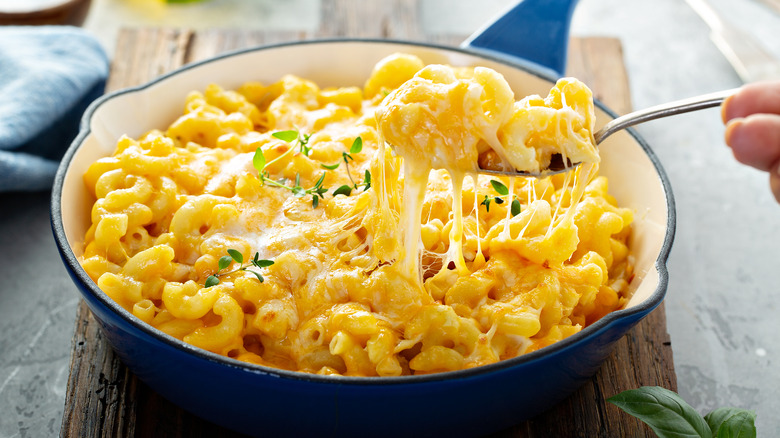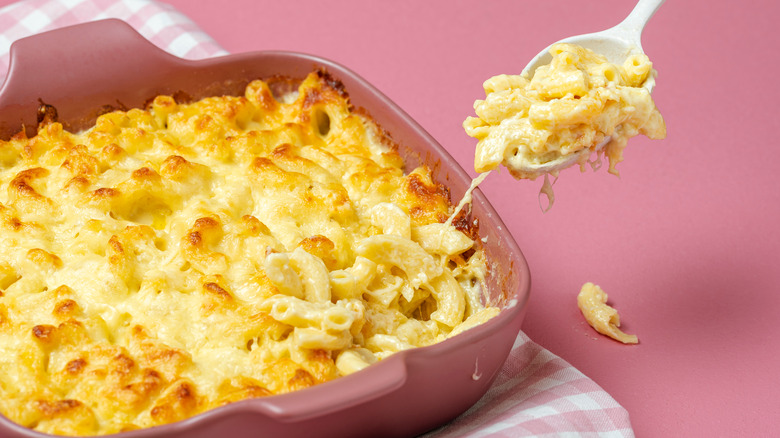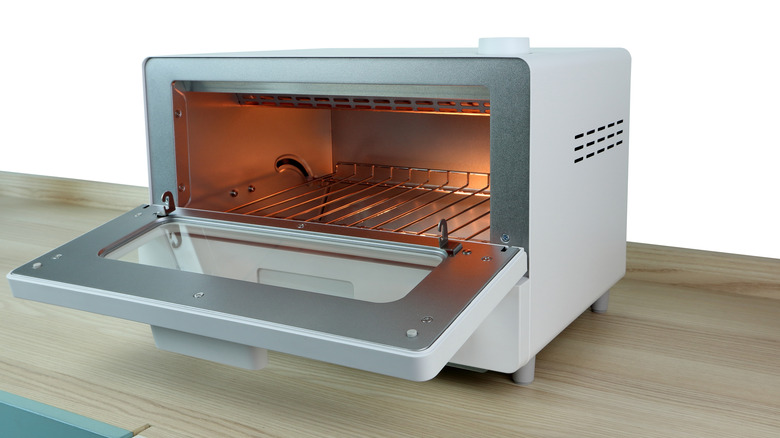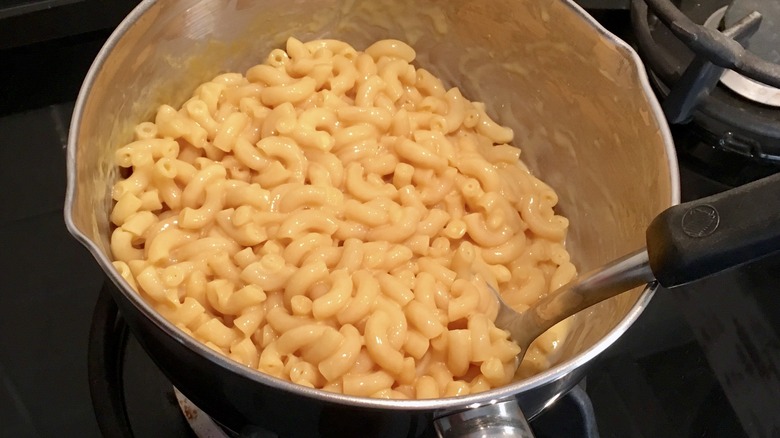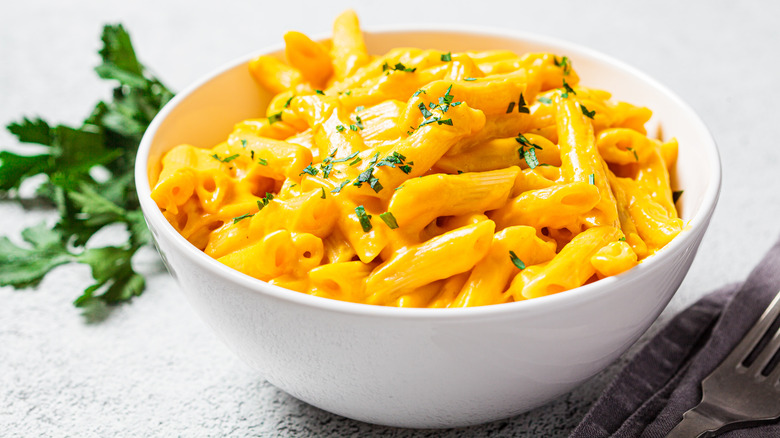Here's How You Should Be Reheating Mac And Cheese
Is there anyone who doesn't love mac and cheese? Rich, comforting, and full of creamy dairy, the classic side dish makes an ideal accompaniment to barbecue, meatloaf, fried chicken, and well, pretty much anything else. Whether you prefer the stovetop version or the oven-baked casserole version, mac and cheese is a delightful dish to have on hand — but it's tricky as a leftover.
These cheesy noodles are notoriously problematic to reheat. When making a cheese sauce, it's important to get the right balance of liquid and fat to get a smooth, emulsified result; but when you store leftover mac and cheese, the pasta will continue to suck up water, throwing off the balance of the sauce and leaving a grainy mess. Plus, the pasta you cooked to al dente before mixing it through the cheese will become overcooked when you reheat it. Still, leftover mac and cheese is better than none at all in our book. Here are some of the best techniques to reheat this tasty dish, with a minimum of mushiness and graininess.
In the oven
The best way to reheat mac and cheese is the way you cooked it initially. If you made the oven-baked type of mac and cheese, then reheating it in the oven is the way to go.
You probably stored your mac and cheese leftovers in the baking dish they were made in, covered tightly with a layer of tinfoil. If so, all you need to do is preheat your oven to 350 degrees Fahrenheit, put the dish in, and reheat until hot and bubbly, about 20 minutes. Then, take off the foil and allow the dish to heat for another 10 minutes. Be careful not to overheat the mac and cheese, which will cause the proteins and fat in the cheese to separate, and which will also make the pasta mushy.
If you made a stovetop version of mac and cheese, and you want to reheat it in the oven, it's not ideal, but it will work. To do so, place some mac and cheese in a glass casserole dish, pour a bit of milk over the top, using one tablespoon of milk per cup of pasta, and gently stir it in. Cover tightly with foil and bake in a 350-degree oven until hot and bubbly, about 30 minutes.
In the toaster oven
If you have a smaller portion of mac and cheese to reheat, you can use the toaster oven. Since a toaster oven is just a small version of an oven, the method here is the same as reheating in a large oven. For baked mac and cheese leftovers, preheat your toaster oven to 350 degrees Fahrenheit. Place a portion of mac and cheese in an oven-safe dish, cover it tightly with tin foil, slip the dish into the toaster oven, and reheat until hot and bubbly, about 20 minutes. Then, take off the foil and allow the dish to heat for another 10 minutes.
To reheat stovetop mac and cheese in your toaster oven, place some mac and cheese in an oven-safe dish, pour a bit of whatever kind of milk you used to make it over the top, using one tablespoon of milk per cup of pasta, and gently stir it in. Cover tightly with foil and bake in a 350-degree toaster oven until hot and bubbly, about 30 minutes.
On the stovetop
If you originally made a stovetop version of mac and cheese, you'll want to go ahead and reheat it on the stovetop, too. To do so, place a portion of mac and cheese in a saucepan or skillet, then pour over a bit of the milk you used to make it, using 1 tablespoon of milk per cup of pasta.
Using low to medium heat, reheat the pasta slowly, stirring to incorporate the milk and adding more as necessary if the mac and cheese seems dry. Heat until completely warmed through, about 10 minutes, being careful not to overheat the pasta, which will make it soggy. You can use this method to reheat oven-baked mac and cheese, if you're in a pinch, but be warned that it will destroy any crispiness you achieved with your breadcrumb or grated cheese topping.
In the microwave
While the microwave can be a tricky way to reheat mac and cheese, as it's more difficult to moderate the temperature and prevent the cheese from separating and getting oily, it's a fine option if you're super hungry and want to eat some mac and cheese, stat.
To microwave leftover mac and cheese, place a portion into a microwave-safe dish, then pour over a bit of the milk you used to make it, using 2 tablespoons of milk per cup of pasta. Mix to combine, then cover the dish with a lid or with some plastic wrap, leaving it slightly open to allow the release of steam. Heat the mac and cheese on medium for one minute, remove it, stir to distribute the heat, and check to see if it's hot enough. If not, continue to heat for 30-second intervals until it is warmed through.
Ways to make leftover mac and cheese even better
A scan through the above tips reveals a common theme: Adding lost moisture back to the macaroni and cheese. Regardless of your chosen reheating method, a splash of milk can work wonders. Stir in a bit of milk during reheating to add moisture and restore the luscious creaminess of your mac and cheese. For an extra layer of richness, consider using heavy cream instead of milk. Or, if your mac and cheese is already on the rich and creamy side, consider using a light chicken or vegetable broth to add moisture. This not only prevents dryness but also imparts a subtle depth of flavor.
You can also use the reheating process to level up your mac and cheese. If you want to make your dish into a more well-rounded meal, incorporate cooked vegetables or your favorite protein during the process. Broccoli, mushrooms, or shredded chicken can turn a simple macaroni and cheese into a weeknight wonder. Also, if reheating in an oven or toaster oven, consider topping your mac and cheese with breadcrumbs, crushed crackers, or even potato chips before baking. This adds a delightful crunch to contrast with the creamy interior.
Just remember to always reheat your mac and cheese at a moderate temperature to prevent overcooking or drying out. Opt for a low to medium setting on your stovetop or a moderate oven temperature. It is also important to stir your mac and cheese gently to distribute moisture evenly. This prevents certain areas from drying out while others remain overly moist.
